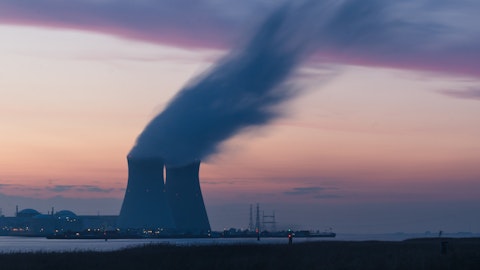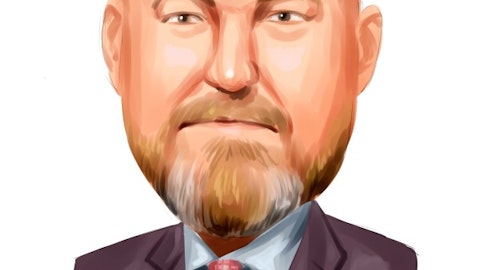Brian Van Abel: Yes, David and I’d just add a couple of points there. One is, we don’t have anything in our current five-year plan related to hydrogen investment opportunities. So to the point, if there’s an opportunity to pull that forward and move faster on hydrogen, absolutely an upside opportunity as we think about it over the next five years. But also lot of, call it, industry discussion about natural gas commodity cost and the volatility we think longer-term now us owning renewables and creating green hydrogen blending it into the LDC creates more price certainty for our customers and takes that volatility out, so I think that’s a longer-term opportunity and benefit as we think about how do we help our natural gas customers and improve the certainty of our overall bills.
BobFrenzel: And then just broadly, and I mentioned this in my prepared remarks was probably worth saying again, which is, we are benefited by the geography that we sit in having great access to low cost wind and low cost solar, not only should we be able to do this for our customers beneficially but you’re looking at opportunity of making the Rocky Mountain region or the upper Midwest regions, energy exports centers where we’re creating a product that can be broadly transmitted to the rest of the country whether that’s electricity via wire or whether that’s green hydrogen via pipe or trucking, we should be a destination for those installations which overtime should help economic development in our states and add to employment backlogs as well.
David Arcaro: That’s really helpful color. Thanks for that, lot of initiatives, it sounds like related to that program that you’ll be rolling out. And then separately on the announcement with Form Energy and long-duration storage, it’s nice to see that crystallizing here. I was wondering if you might have a sense for how much long-duration storage might make sense on your system over time? Is there a certain number of megawatts or a proportion relative to your generation fleet that might make sense. Wondering how you might see the scale up to the extent these initial projects are successful and make it through the regulatory process?
BobFrenzel: Yes, thanks, David. As we go through resource plans with each of our states, we find that we have increasing need for as we have higher penetration of renewables and increasing need for, what we’ll call, dispatchable energy resources, and historically, those would have been combustion turbines maybe they are fired with a clean fuel like hydrogen or synthetic natural gas. Over time as long-duration storage might become more feasible and cost effective, you can see duration — long-duration storage being a part of that solution, and I think if I were to add-up and I’m going to do this math on the fly, but we have several thousand megawatts in our resource plans for firm dispatchable generation. And if we had an asset, lithium-ion batteries are interesting and they have a utilization for our systems, but so do the long-duration storage.
These are 20 megawatts projects, there’s probably several 100 in our resource plans that could be realizable within the next five to 10 years if the technology proves out.
Brian Van Abel: Yes, and I would just add to that, we’re really excited about this technology, shows that we’re leading and really demonstrating that we’re on the forefront of this clean energy transition and we’ve always talked about we know how to get to our 2030 goals of 80% plus carbon reduction and so this is really about taking that last 15% to 20% out of the stack and providing one of the solutions. So if you think about that and when you look at our resource mix in 2030, you can start to size what do we need to do beyond that in terms of storage capabilities that will be one of the solutions.
Operator: Thank you so much, sir. We now go to Jeremy Tonet from JPMorgan. Please go ahead.
Unidentified Analyst: Hi, good morning. It’s actually Rich on for Jeremy. Thank you for the time today. Maybe starting with changes to one of your drivers. I know we had out O&M already but just curious if you can parse the full range of what are effectively true-ups for ’22 actuals versus new expectations for ’23, are any of these changes you’re putting in higher or lower within the guidance range at this point in time?
BobFrenzel: I’ll just read up to start, right, we’re still feeling our midpoint of the guidance range, early in the year is where we expect to be and in terms of specific changes, right, gas sales is up a little bit, but that’s really a function of where we landed on the year-end and really gas sales for us 1% is less than $5 million in terms of a change. The increase in the rider revenue that’s a function of we had a good wind in PTC year in 2022, so that’s relatively earnings neutral, we do see a little bit of a benefit depreciation and interest expenses lower. Let’s see the forecasted rates for 2023 are lower than in Q3. But overall, we look at it is relatively neutral as we think about the puts and takes and so we’re now targeting midpoint of the guidance range and now looking-forward to having a discussion 12 months from now and our goal is to deliver for the 19th straight year.
Unidentified Analyst: Great, thanks for the color there. And then turning back to Colorado and a lot of their focus on the gas system quite excited, you addressed this a little bit in the equity plan perspective, but I’m curious for your higher level thoughts on how this might impact your electric operations in state as well?
BobFrenzel: Hi, Rich, it’s Bob. Look, I did mentioned as part of our Clean Heat Plan in our long-term strategy for decarbonizing on behalf of our customers that we do expect some amount of beneficial electrification to happen whether that’s water heaters or cooking or home heating, but we believe that the asset value of the distribution system is incredibly valuable for our customers and has the ability to deliver a significant amount of energy on the coldest days in Colorado, our design temperature that we planned for in Colorado is minus 30, so it’s still a very cold weather climate, has a need for a very efficient delivery system which we believe the pipeline system is there. Now, I do think that we can put — as part of our strategy is to look at clean fuels and green hydrogen and synthetic natural gas and the opportunity that presents for our customers to realize a good product at an affordable price, that’s also sustainable, it’s important.
But electrically, with EV’s and beneficial electrification as we think about the future of our electric business in Colorado, there’s probably growth there that’s driven by both of those aspects.
Operator: Thank you very much, sir. We’ll now move to Julien Dumoulin-Smith of Bank of America. Please go ahead.
Julien Dumoulin-Smith: Hi, good morning, team. Thanks for the time and the opportunity, nicely done. So Brian just on the — so, just first on bills, I just want to understand a little bit on the trajectory of bills, can you talk a little bit on what the rate increases are in customers this winter especially on the gas side? And then also just given the cresting that we’ve seen in some of the commodity prices here, how is that setting itself up to ultimately get reflected to back to your customers, if you think about the cadence of your hedging programs?
Brian Van Abel: Yes. Hi, Julien. Good question, and we think about — I’ll talk a little bit about both sides of the business because we think about on the electric side really well-positioned from overall customer bill perspective. Now we’re, call it, 85% electric and if you just look at our income statement and the cost of goods sold and fuel impacts on the electric side is modest given the inflationary environment we saw in 2022, Bob talked about it, right, it’s really — it’s our wind build out that we’ve always talked about been the hedge for rising commodity costs and that’s played out in 2022 and really good to see from a customer bill perspective. And also we went into the year, being on a national average, more than 20% lower on residential customer per bill.
So, good place and a good place to be on the electric side. Obviously, on the natural gas LDC side, you have a lot fewer levers and lot fewer assets. And so you saw some of the headlines of 40% to 50% bill impacts for our customers, obviously, we do not like to see any sort of bill impacts of that magnitude, but you’re absolutely right that that is starting to subside with where natural gas prices are going. And if you caught it, we’ve just, in the past few months, we twice updated our gas commodity clause in Colorado which lowered the gas — the commodity portion of the customers’ bills by about 30% that will start to feel in Q1 relative to Q4 because we’re actually going to be over collected, so we proactively did that and the commission was appreciative of that.
So we’re certainly taking every opportunity we can to make sure that we have reflecting the lower commodity costs in our customers. So that’s really where we see, I think longer-term, we feel really good about delivering bills at the level of inflation as we think about 2030 and beyond and what the IRA is doing for us and for our customers. So we feel good both near-term and longer-term as we think about it.





